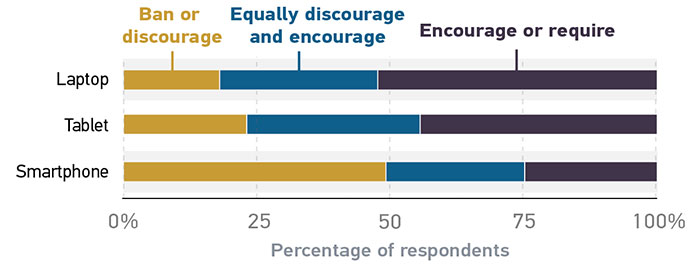Community College Faculty Want Students to Use Laptops but Not Smartphones
Smartphones are significantly more important for academic success to non-white, first-generation college students, students whose families have lower incomes, and those with disabilities—populations that make up a good portion of community college students—than they are to other groups of students.1 So when it comes to using technology in the classroom, it makes sense to allow students to use the devices they own and are the most reliable for them. However, faculty still frequently ban students from using their devices (figure 5), though there is scarce research to support such classroom policies.2 Is there anything that institutions can do to increase faculty acceptance of the devices that are important to these students?

Not unlike their four-year colleagues, community college faculty generally promote the use of laptops and tablets, but nearly half ban or discourage smartphones in their classrooms.3 However, two-year faculty who believe they could be better instructors by increasing skills in integrating these devices in the classroom were less likely to ban them. Importantly, training does appear to mitigate bans. Faculty who received training were more likely to encourage their students to use their phones and laptops in class; faculty who had not received this training banned or discouraged these devices more often.
Faculty need support and training to use technology in their classrooms for learning, particularly in working with students who rely solely on their smartphones. But receiving this support does not guarantee that faculty will encourage students to use their personal technologies during class. Institutions must not only offer faculty training on how to integrate these devices into their classrooms but also ensure that training impacts faculty attitudes and adoption of these practices. Harnessing the technology that a majority of students have at their disposal can serve to quash the debate on devices in the classroom and diminish the digital divide for low-income students.4
Notes
-
Gierdowski, ECAR Study of Community College Students and Information Technology, 2019.
↩︎ -
Katie Rose Guest Pryal, "When You Talk about Banning Laptops, You Throw Disabled Students under the Bus," HuffPost (November 27, 2017).
↩︎ -
Galanek and Gierdowski, ECAR Study of Faculty and Information Technology, 2019.
↩︎ -
Ibid.; Lindsay McKenzie, "Smartphones for All Students: An Academic Equalizer in an Era of Income Inequality?" Inside Higher Ed, December 5, 2018.
↩︎